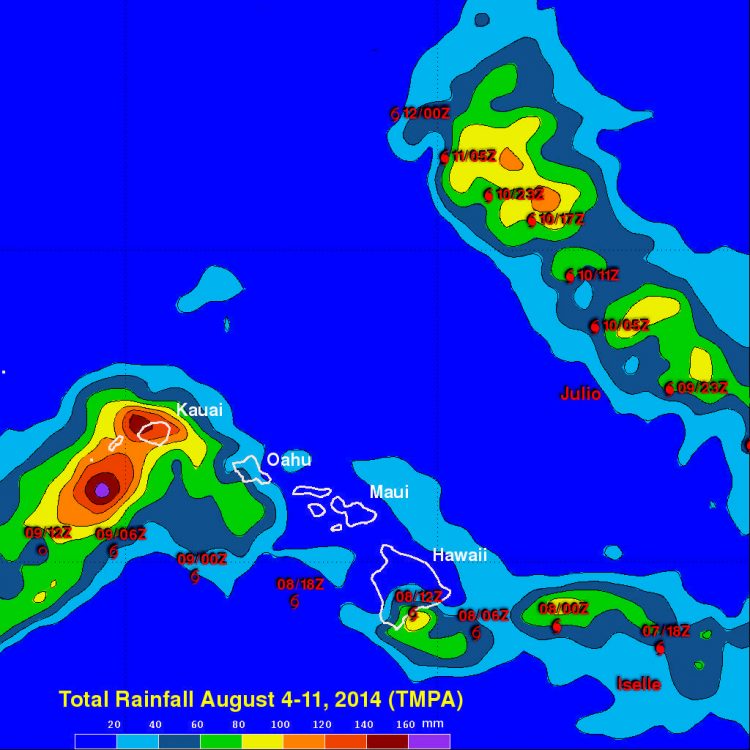Tropical Storm Iselle Departs Hawaii While Julio Stays Well North

Rainfall estimates for the period Aug. 4 to 11 for the Hawaiian Islands. Two swaths of heavier rain show the paths of Iselle and Julio. Iselle's rainfall totaled 60 to 80 mm (~3 inches, green) over the southeast coast of Hawaii and upwards of 120 mm (~5 inches, red) over Kauai. Image Credit: SSAI/NASA, Hal Pierce
Iselle was once a rather powerful category 4 hurricane in the East Pacific with sustained winds estimated at 120 knots (~138 mph) by the National Hurricane Center. Fortunately, a combination of southwesterly wind shear, drier air and cooler waters weakened Iselle considerably as it approached the Hawaiian Islands.
Although much weaker, Iselle still struck the southeast Kau coast of the Big Island of Hawaii as a rather strong tropical storm. In fact Iselle, was the strongest and only the second tropical storm to hit the Big Island in over 50 years. The center made landfall around 2:30 am HST on Friday, August 8, near Pahala with sustained winds of 60 mph.
The Big Island bore the brunt of the storm where downed trees and power lines left 25,000 people without power. Currently, several days after the storm, around 8,000 are still without power on the island. After hitting the Big Island, Iselle continued to track to the west-northwest keeping the center of circulation well south of the rest of the Hawaiian Islands, which mainly received just rain from Iselle's outer rainbands. On Kauai, however, one woman was reported to have been swept away and drowned while hiking.
TRMM captured an image of Iselle on August 9 at 09:06 UTC (August 8 at 11:06 p.m. local time) as the center was passing well south of the far western islands of Kauai and Ni'ihau. By that time, Iselle had been degraded to a tropical depression, and TRMM showed the exposed center of Iselle, which was devoid of any eyewall or even rain. There are several outer rainbands located only on the northeast side of the storm that were still effecting the western part of the state.
Data from that same satellite over pass (orbit) was used to create a 3-D image of the storm looking north. Areas in green show that much of the rain is relatively shallow with tops ranging from about 5 to 8 km, but there are isolated areas of higher tops associated with deeper penetrating individual convective cells embedded within the rainbands.
At NASA's Goddard Space Flight Center in Greenbelt, Maryland a TRMM-based, near-real time Multi-satellite Precipitation data (TMPA) analysis was conducted that uses TRMM data to calibrate rainfall estimates from other satellites. The analysis expands the rainfall coverage of the TRMM satellite. TMPA rainfall estimates were calculated to cover August 4 to 11 for the Hawaiian Islands and surrounding area.
Two swaths of heavier rain showed the paths taken by Iselle and Julio, which formed a few days after Iselle and followed a path slightly more to the north. Iselle's rainfall totals are on the order of 60 to 80 mm (~3 inches) over the southeast coast of Hawaii and upwards of 120 mm (~5 inches) over Kauai. Locally, up to 14 inches of rain was reported in the higher elevations of the Big Island.
Julio, which is now a tropical storm, is currently located well north of Oahu (about 500 miles from Honolulu) and expected to continue moving away from Hawaii and steadily weaken.
TRMM is a joint mission between NASA and the Japanese space agency JAXA.
Text credit: Stephen Lang
SSAI/NASA Goddard Space Flight Center
Media Contact
More Information:
http://www.nasa.gov/content/goddard/iselle-eastern-pacific-ocean/All latest news from the category: Earth Sciences
Earth Sciences (also referred to as Geosciences), which deals with basic issues surrounding our planet, plays a vital role in the area of energy and raw materials supply.
Earth Sciences comprises subjects such as geology, geography, geological informatics, paleontology, mineralogy, petrography, crystallography, geophysics, geodesy, glaciology, cartography, photogrammetry, meteorology and seismology, early-warning systems, earthquake research and polar research.
Newest articles

Bringing bio-inspired robots to life
Nebraska researcher Eric Markvicka gets NSF CAREER Award to pursue manufacture of novel materials for soft robotics and stretchable electronics. Engineers are increasingly eager to develop robots that mimic the…

Bella moths use poison to attract mates
Scientists are closer to finding out how. Pyrrolizidine alkaloids are as bitter and toxic as they are hard to pronounce. They’re produced by several different types of plants and are…

AI tool creates ‘synthetic’ images of cells
…for enhanced microscopy analysis. Observing individual cells through microscopes can reveal a range of important cell biological phenomena that frequently play a role in human diseases, but the process of…





















